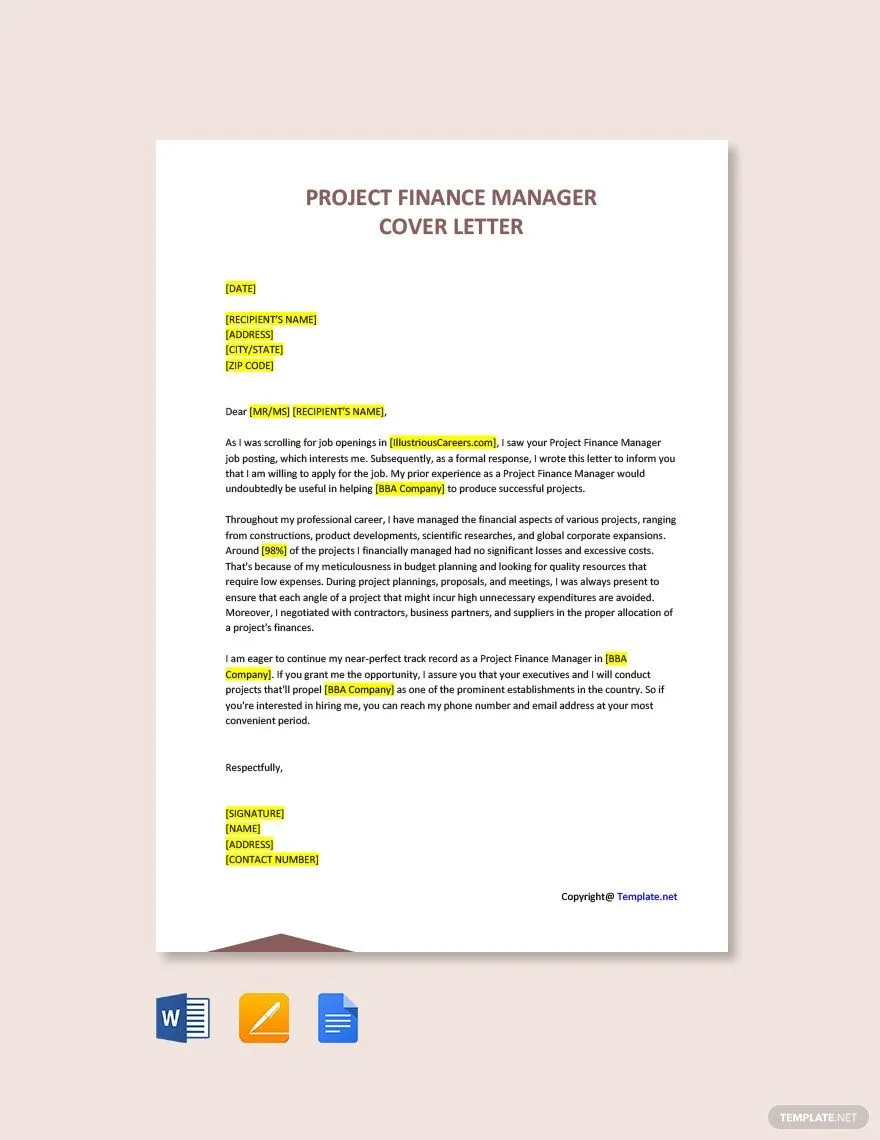What is a Financial Manager?
A financial manager is a crucial role within any organization, responsible for overseeing the financial health of a company. This professional analyzes financial data, monitors financial transactions, and provides strategic recommendations to improve profitability and efficiency. Financial managers play a vital role in making sound investment decisions, managing risk, and ensuring regulatory compliance. They work to develop financial strategies, forecast financial performance, and create budgets. Their expertise spans a wide range of areas, from managing cash flow to evaluating investment opportunities. The role demands a strong understanding of financial principles, accounting practices, and economic trends, along with exceptional analytical and communication skills. A financial manager is essentially the financial conscience of a business, working to ensure its long-term financial sustainability and success.
Financial Manager Responsibilities
The responsibilities of a financial manager are diverse and encompass a broad range of activities, all geared toward ensuring the financial well-being of the organization. Key responsibilities include financial planning and analysis, which involves creating budgets, forecasting financial performance, and analyzing variances. Financial managers are also involved in investment decisions, evaluating potential investment opportunities, and managing the company’s portfolio. Managing cash flow and working capital is another critical area of focus, ensuring that the company has sufficient funds to meet its obligations and operate efficiently. Furthermore, financial managers are responsible for risk management, identifying and mitigating financial risks, and ensuring compliance with financial regulations and reporting requirements. They often oversee financial reporting, preparing and analyzing financial statements to provide insights into the company’s financial performance. Moreover, they collaborate with other departments to develop and implement financial strategies that support the company’s overall goals.
Why a Cover Letter is Crucial for Financial Managers
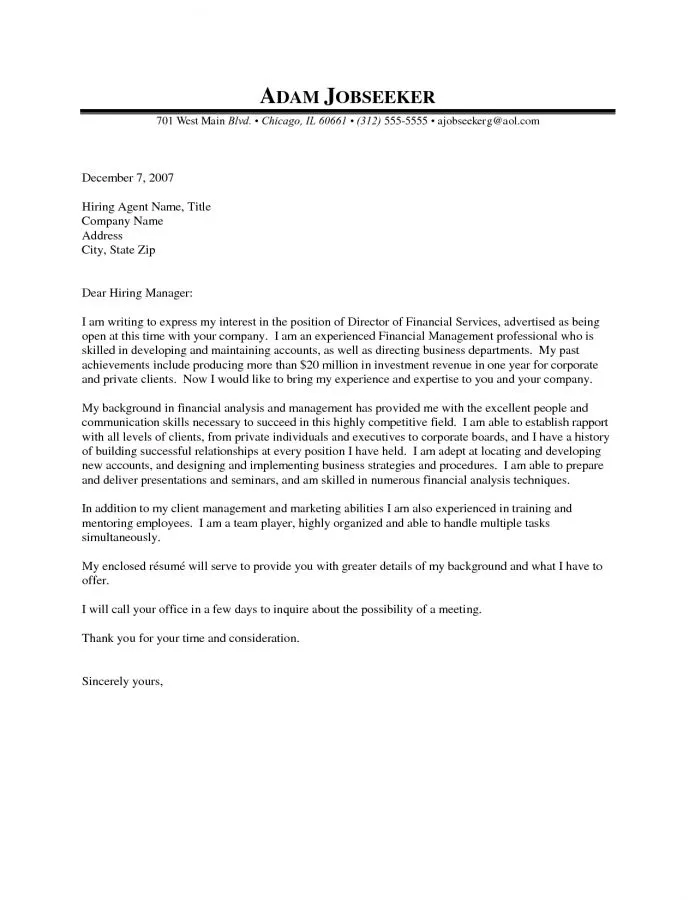
A cover letter is not just an optional extra when applying for a financial manager position; it’s a vital tool. It’s an opportunity to go beyond the resume and demonstrate your understanding of the role and the company’s needs. The cover letter allows you to showcase your communication skills, a crucial asset for financial managers who must clearly articulate complex financial information to various stakeholders. It offers a chance to highlight specific skills and experiences that directly align with the job requirements, tailoring your application to the specific opportunity. A well-crafted cover letter can differentiate you from other applicants, as it allows you to demonstrate your personality, enthusiasm, and genuine interest in the role and the company. In a competitive field like finance, a compelling cover letter can be the deciding factor in securing an interview. It provides a platform to explain any gaps in your resume or to elaborate on significant accomplishments that might not be fully detailed in your resume. Ultimately, the cover letter is your personal marketing document, designed to convince the hiring manager that you are the ideal candidate.
Key Components of a Financial Manager Cover Letter
A strong cover letter for a financial manager position needs to be structured to make a good impression. Each component plays a crucial role in conveying your suitability for the role. The following sections provide a framework for crafting a compelling letter.
Header and Contact Information
Start your cover letter with a professional header that includes your name, address, phone number, and email address. Ensure your contact information is accurate and up-to-date, as this is how potential employers will reach you. Consider using a professional-looking email address; avoid casual or unprofessional handles. If you have a LinkedIn profile, include the URL in your header to provide the hiring manager with easy access to your professional profile and expand the details of your career.
Professional Greeting
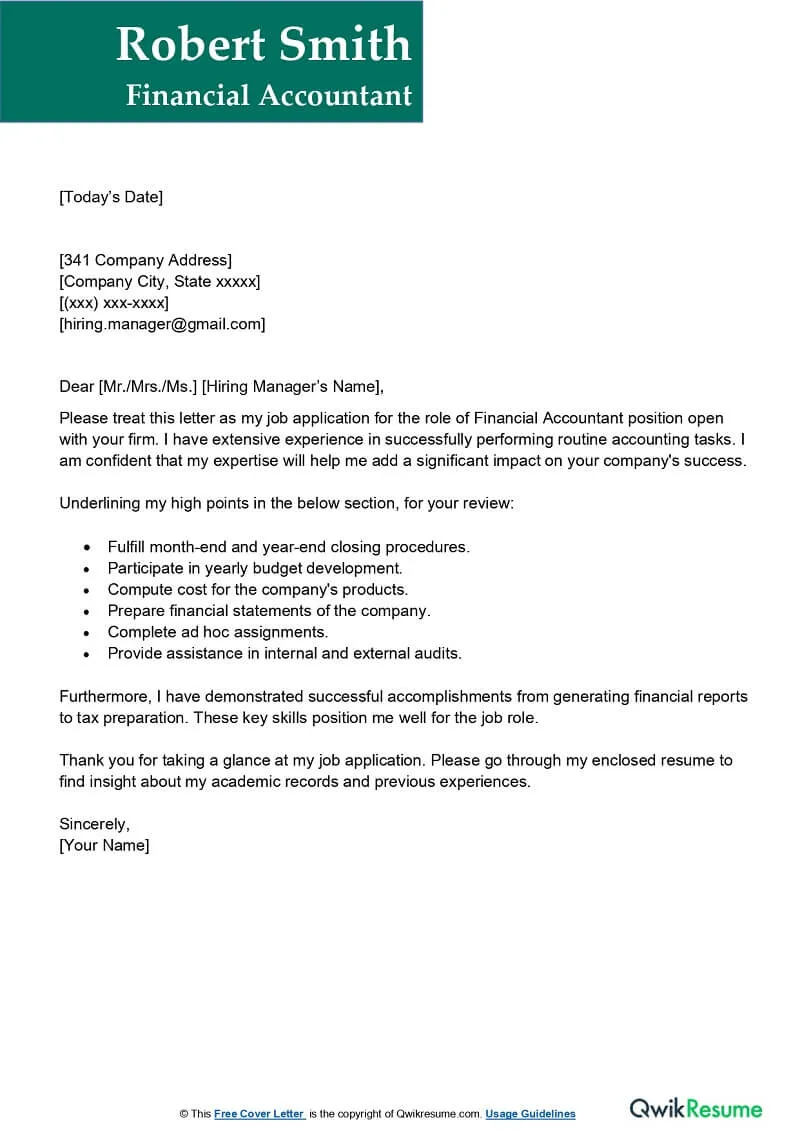
Address the hiring manager by name if possible. Research the company to find out the name of the hiring manager or the person responsible for reviewing applications. Using a specific name shows that you have taken the time to research the company and are genuinely interested in the role. If you cannot find a specific name, a formal greeting such as “Dear Hiring Manager” or “Dear [Department Name] Team” is an acceptable alternative. Avoid generic greetings like “To Whom It May Concern,” as they can make your letter seem impersonal and less impactful.
Opening Paragraph Grabbing Attention
The opening paragraph is your opportunity to capture the reader’s attention. State the position you are applying for and where you saw the job posting. Briefly mention why you are excited about the opportunity and what attracted you to the company. This is also the place to include a concise statement highlighting your most relevant skills or experience. Your aim here is to create a strong first impression and immediately demonstrate your understanding of the role and the company’s needs. The goal is to create an impression of competence and confidence that would make a hiring manager read the rest of your cover letter.
Highlighting Relevant Skills and Experience
In the body of your cover letter, highlight the skills and experience that align with the job requirements. Review the job description carefully and identify the key skills and qualifications the employer is seeking. Then, provide specific examples from your work history that demonstrate how you have successfully applied those skills. This is where you showcase your expertise in financial planning, budgeting, analysis, risk management, and any other relevant areas. Quantify your achievements whenever possible, using numbers and data to illustrate your impact. Focus on your accomplishments, not just your responsibilities. Clearly articulate how your skills and experience have led to positive outcomes in previous roles.
Quantifiable Achievements to Showcase Impact
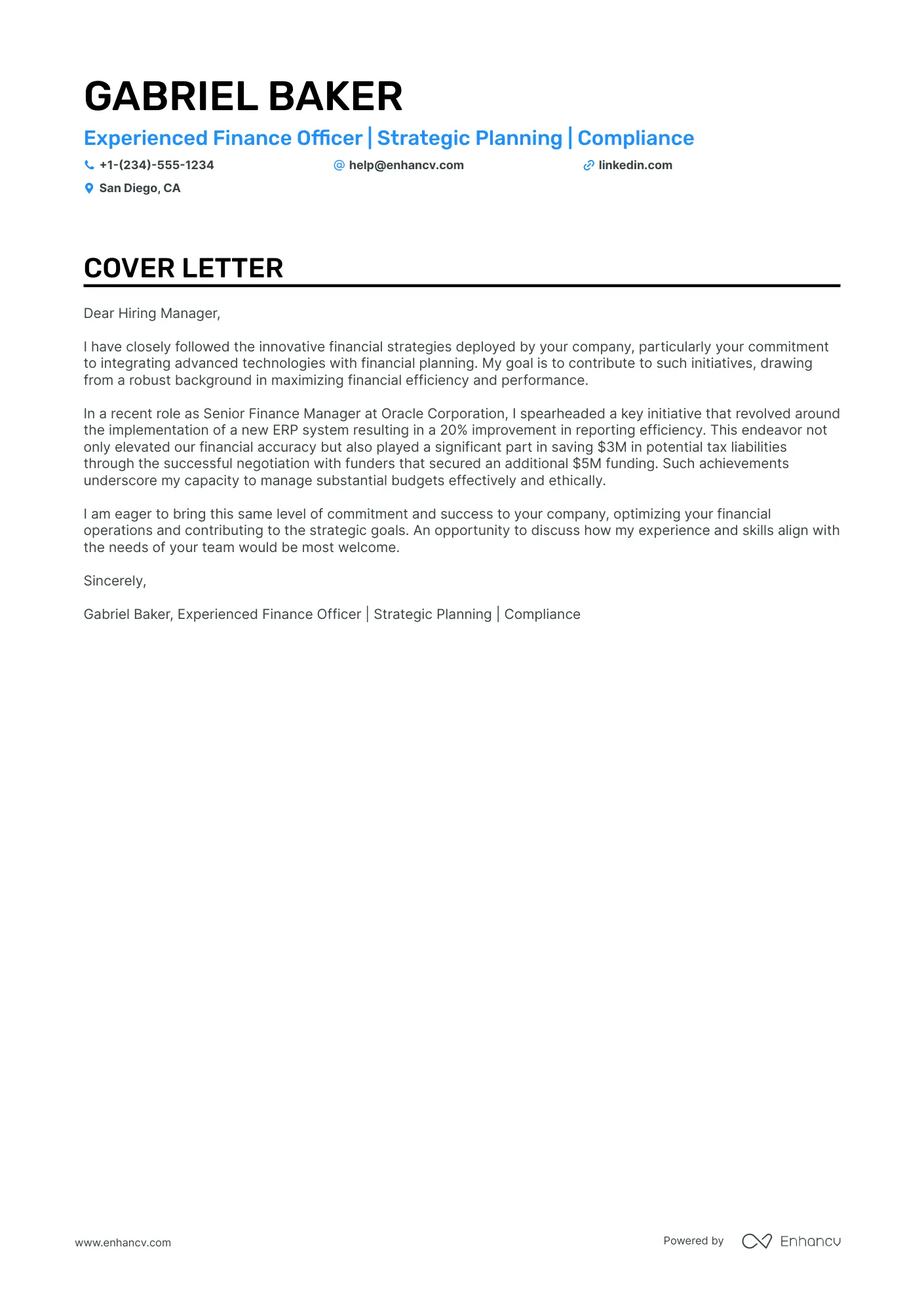
Quantifying your achievements is one of the most effective ways to demonstrate your value as a financial manager. Instead of simply stating your responsibilities, use numbers and data to illustrate the impact of your work. For example, instead of saying “Managed the budget,” state “Managed a $50 million budget and reduced spending by 10%.” Use percentages, dollar amounts, and other metrics to showcase your successes. This shows potential employers the real-world results of your skills. When possible, include specific examples of projects, initiatives, or strategies that you have implemented and the positive outcomes that resulted. This might include improving financial forecasting accuracy, reducing costs, increasing revenue, or streamlining financial processes. Highlighting these achievements demonstrates your ability to deliver results and contribute to the company’s financial success.
Demonstrating Knowledge of Financial Principles
Showcase your deep understanding of financial principles and concepts in your cover letter. Briefly mention your knowledge of financial accounting, budgeting, financial analysis, and investment management. Tailor your descriptions of these principles to the specific requirements of the job. For instance, if the job involves financial forecasting, emphasize your experience with forecasting techniques and the accuracy of your predictions. If the role requires knowledge of GAAP or IFRS, state your familiarity with these accounting standards. Your ability to speak the language of finance shows that you are a well-prepared professional who understands the complexities of the role. Demonstrate that you can apply these principles to solve complex financial problems.
Tailoring the Cover Letter to the Specific Job
Customizing your cover letter for each job application is essential. Generic cover letters are easy to spot, and they often fail to make a strong impression. Before you start writing, carefully read the job description and identify the key requirements, skills, and qualifications that the employer is seeking. Use this information to tailor your cover letter. Highlight the experiences and skills that directly align with the job requirements. Use the same keywords and phrases from the job description to demonstrate that you understand the role and the company’s needs. This shows that you have the specific qualifications the company is looking for. If possible, mention specific details about the company, the department, or the projects that resonate with your experience and interests.
Researching the Company
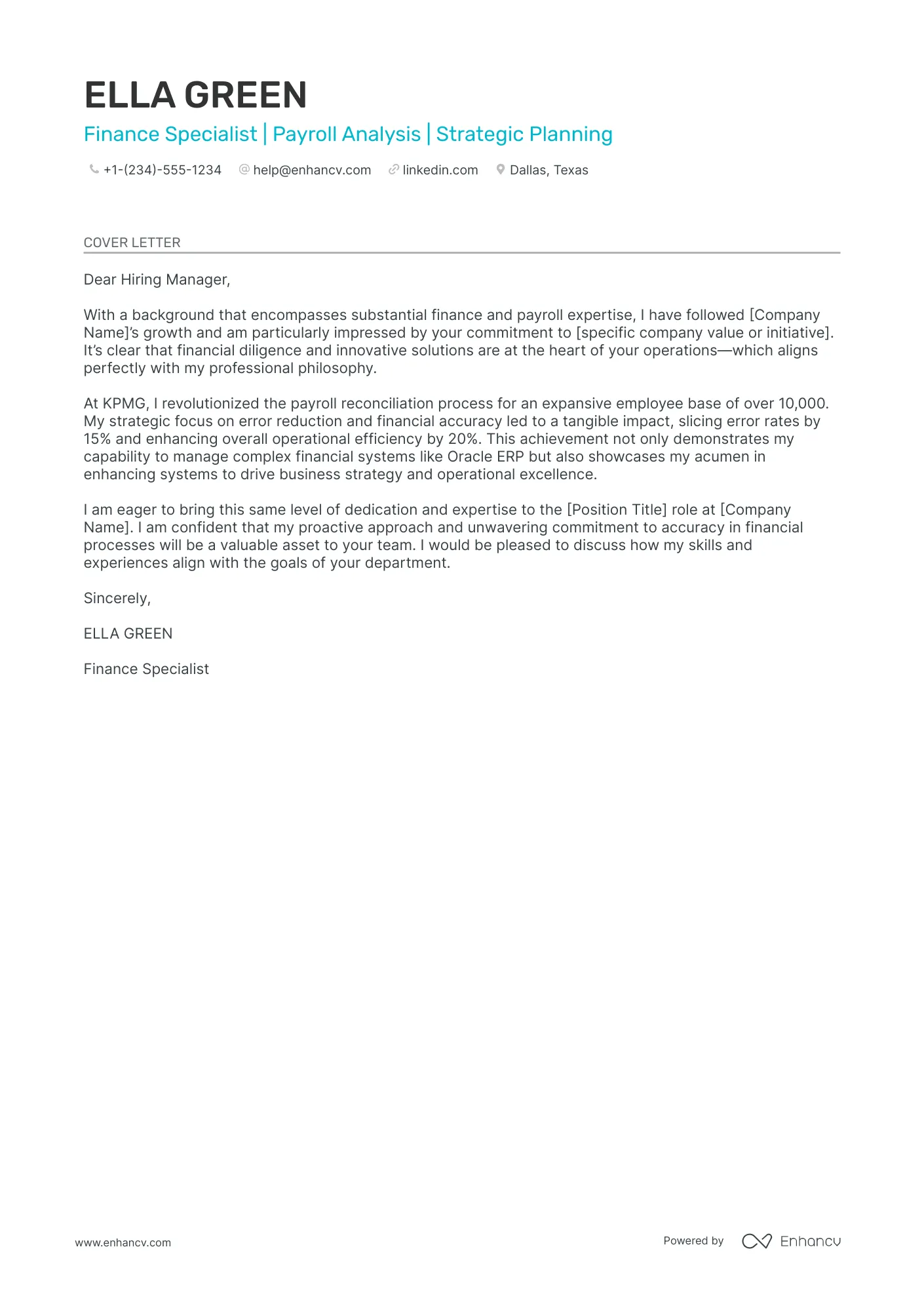
Before writing your cover letter, research the company thoroughly. Understanding the company’s mission, values, and current initiatives shows your genuine interest and helps you tailor your letter effectively. Visit the company’s website, read news articles about the company, and browse its social media profiles. Look for information about the company’s financial performance, recent projects, or industry trends. This research allows you to tailor your cover letter to the specific needs of the company, aligning your skills and experience with their goals. Show that you understand the company’s industry, its competitors, and its challenges. Incorporating this research will impress the hiring manager and demonstrate that you are seriously interested in the opportunity.
Matching Skills with Job Requirements
Carefully compare your skills and experiences with the requirements listed in the job description. Identify the key skills and qualifications the employer is seeking. These might include financial modeling, budgeting, forecasting, risk management, or specific software proficiencies. In your cover letter, clearly highlight how your skills match these requirements. Provide specific examples from your past experiences to demonstrate how you have successfully applied those skills. Use the same keywords and phrases from the job description to show that you understand the role. This process is about showcasing your ability to deliver the skills required by the company. Show that you can use your abilities to address the problems the company is trying to solve or achieve their goals.
Formatting and Tone
The format and tone of your cover letter are just as important as the content. Proper formatting makes your letter easy to read and professional. The tone should be confident and enthusiastic, demonstrating your interest in the role and the company. These elements work together to make a good impression.
Professional Formatting Tips
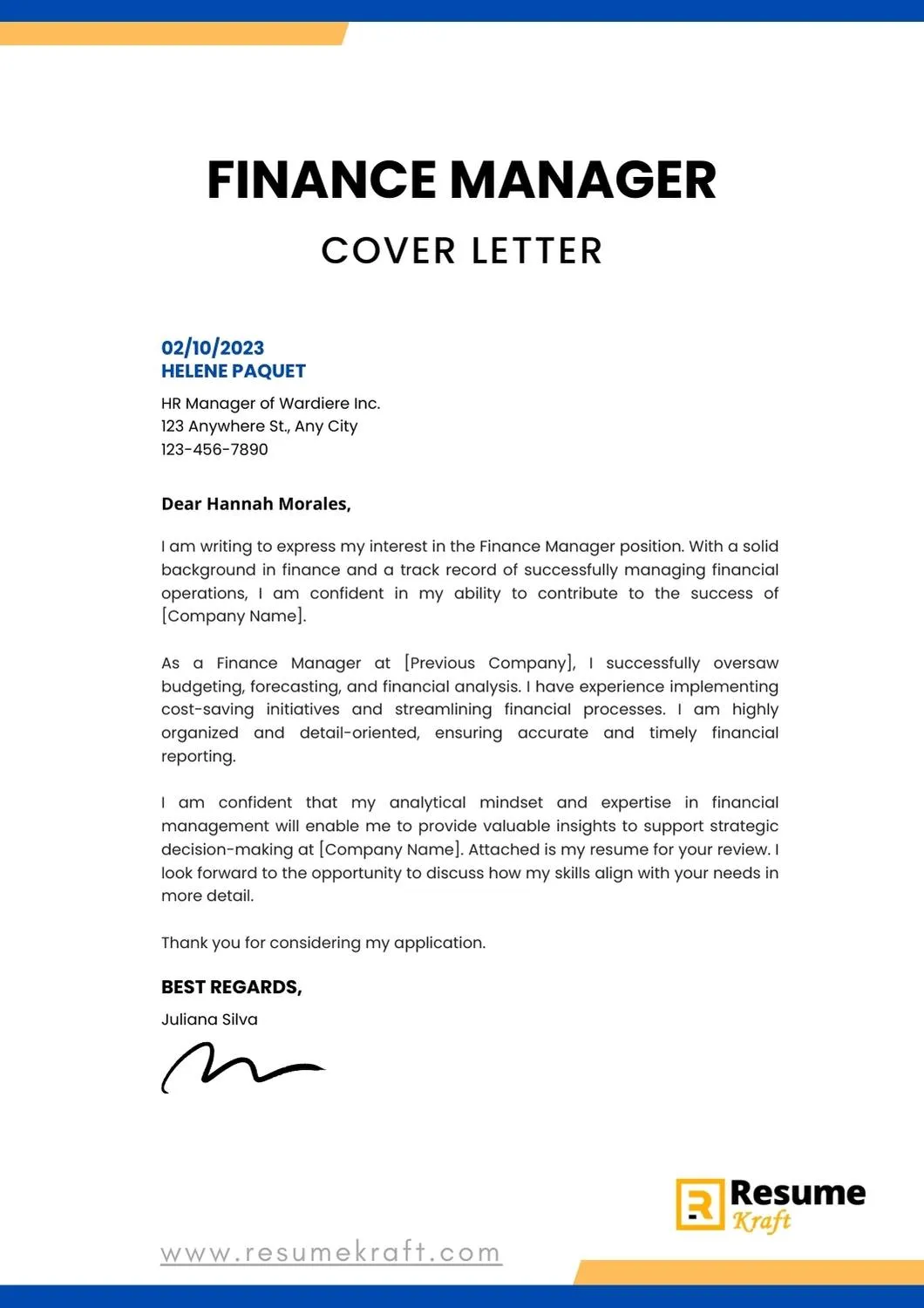
Use a clean, professional font such as Times New Roman, Arial, or Calibri, and maintain a consistent font size (10-12 points). Use standard margins (1 inch on all sides) and single-space your text, with a blank line between paragraphs. Keep your letter to one page; hiring managers are often overwhelmed with applications, so it’s important to keep your letter concise. Use clear headings and bullet points to make your letter easy to read and visually appealing. Proofread carefully to ensure there are no typos or grammatical errors. Make sure that your formatting is consistent throughout the letter and that your cover letter looks tidy and well-organized.
Maintaining a Confident and Enthusiastic Tone
Your cover letter should convey your enthusiasm for the opportunity. Use confident language that showcases your skills and experience, highlighting your accomplishments rather than just listing your responsibilities. Use active voice and strong verbs to make your writing more impactful. Avoid overly formal or passive language. Show your personality and passion for finance, but maintain a professional tone. Express your genuine interest in the company and the role. Your tone reflects your attitude to the hiring manager. Be polite and respectful. The aim is to express your enthusiasm while maintaining professionalism to increase your chances of an interview.
Closing the Cover Letter
The closing of your cover letter is your last opportunity to leave a positive impression. It is crucial to end it strongly.
Expressing Interest and Call to Action
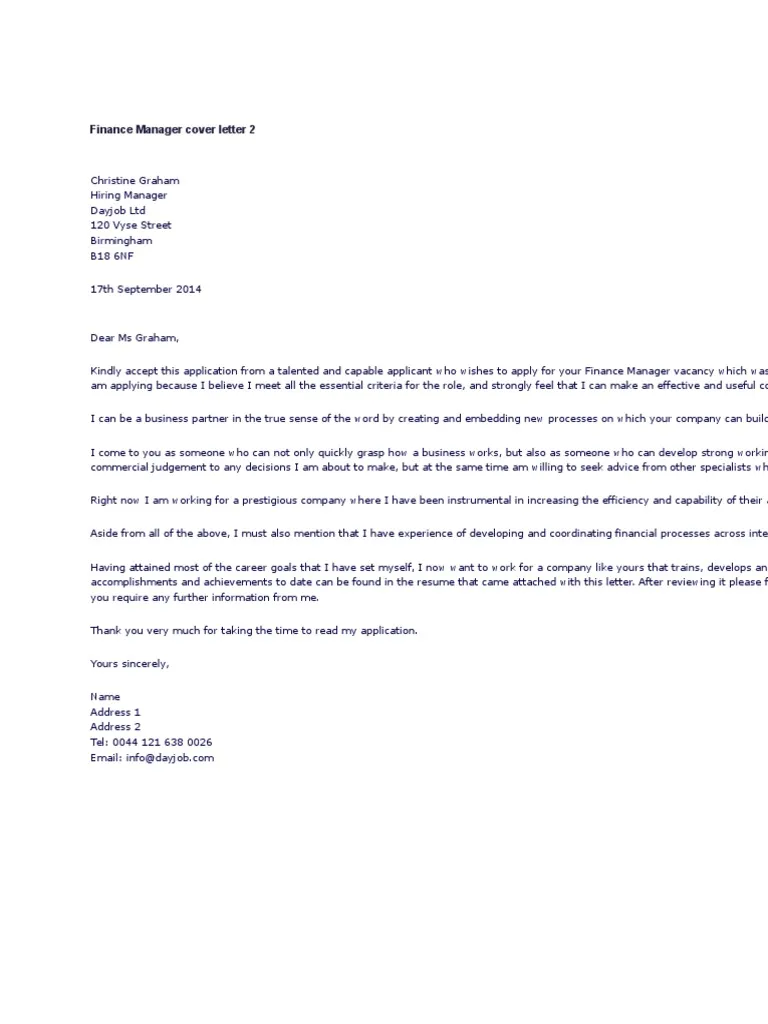
Reiterate your interest in the position and the company. Thank the hiring manager for their time and consideration. Express your availability for an interview and your eagerness to discuss your qualifications further. Provide your contact information again, making it easy for the hiring manager to reach you. Use a professional closing such as “Sincerely” or “Best regards”, followed by your name. By ending with a call to action, you encourage the hiring manager to take the next step. A strong closing can significantly increase your chances of getting an interview and landing the job.
Proofreading and Editing
Before you submit your cover letter, proofread and edit it carefully. Typos, grammatical errors, and inconsistencies can damage your credibility and make you appear unprofessional. Check for any spelling mistakes, grammatical errors, and punctuation errors. Ensure that your writing is clear, concise, and easy to understand. Use a spell checker and grammar checker, but also read the letter yourself to catch any errors that automated tools might miss. Ask a friend, family member, or career advisor to review your cover letter for a second opinion. They can provide valuable feedback on your content, formatting, and tone. A well-edited cover letter demonstrates your attention to detail and commitment to quality.
Common Mistakes to Avoid
Avoiding common mistakes can significantly improve the effectiveness of your cover letter. Mistakes can be the difference between getting an interview and being overlooked. Here are some common pitfalls to avoid.
Using Generic Language
Avoid using generic, cliché language in your cover letter. Statements like “I am a hard worker” or “I am a team player” are overused and don’t provide any specific information about your abilities. Replace these generic statements with concrete examples of your skills and accomplishments. For instance, instead of saying “I am good at budgeting,” state “Successfully managed budgets ranging from $1M to $10M, consistently achieving a variance of less than 2%.” Avoid using buzzwords or jargon unless they are directly relevant to the job and the company’s industry. Use specific, detailed examples to demonstrate your qualifications. The focus should always be on illustrating your capacity to meet the requirements of the role.
Failing to Quantify Achievements
One of the biggest mistakes job seekers make is failing to quantify their achievements. Instead of simply listing your responsibilities, use numbers and data to illustrate the impact of your work. For example, instead of saying “Improved efficiency,” state “Improved operational efficiency by 15% through the implementation of a new inventory management system.” Quantifying your achievements provides concrete evidence of your value and effectiveness. Use metrics, percentages, dollar amounts, and other measurable data to showcase your accomplishments. Quantifying your accomplishments makes your achievements more compelling and memorable. Ensure that you are always using numbers and data to illustrate your positive impact.
Typos and Grammatical Errors
Typos and grammatical errors can undermine your credibility and make you appear unprofessional. Proofread your cover letter carefully before submitting it. Use a spell checker and grammar checker to catch any obvious errors, but don’t rely on these tools alone. Read your letter multiple times to catch any mistakes that automated tools might miss. Ask someone else to review your cover letter as a fresh pair of eyes can often identify errors that you might miss. Even a few minor errors can give the impression that you are not detail-oriented. A well-written, error-free cover letter demonstrates your professionalism, attention to detail, and commitment to quality. Remember that your cover letter is your first impression; make it a good one.
